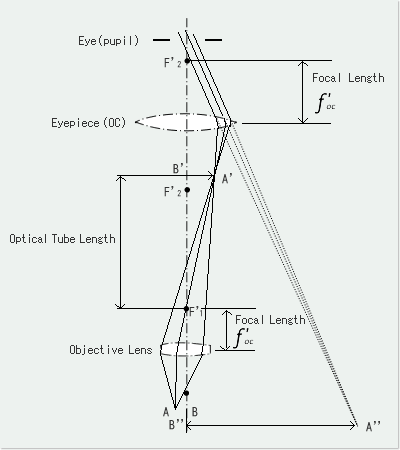
The optical microscope, is a type of microscope which uses visible light and a system of convergence lenses to magnify images of small samples.

A is the object and A'' is the final image of A.
Major Parts of Optical Microscope

This is monocular microscope, because it has only one eyepiece. It called binocular or stereo if has two eyepiece.
- objective lens- closest to the object.
- eyepiece- closest to the eye.
- Course focus- Stage up and down
- Fine focus- Stage up and down slowly
- Stage Controls- Control horizontal movements of stage.
- Illuminator - Illuminate the sample on stage using halogen bulb
- Irish Diaphragm- Disk Diaphragm- which control amount light on the sample.
Cleaning of non optical Parts.
First remove dust partials using soft brush.
Then it can be clean using a water damped cotton cloth. Never use chemicals which is not recommended by product manufacture because it can be harmful to the surface and surface protective layers.
It is recommended to use dust cover when not in use.
Lubrication
microscope lithium based grease can be used, but keep in mind don't lubricate objectives. Don't use general purses lubricant.
Cleaning of optical parts.
Following are necessary to carry out this proposes correctly.
First use Dust bulb to remove dust particle on the lenses. If their is remaining contaminants use camel brush in vertically and smoothly to remove dust. A very tiny scratch on a optical lens could result in a huge imperfection on final image.
Then observe any any contaminant or fungus on lenses. To check this turn on microscope look carefully any of them can see. If is their try to identify actual position while turning eyepiece. Then use Q-tips, Lenses cleaning solution and lenses cleaning papers to to clean them. Move your tips on the lenses in circular motion while cleaning lenses.
Finally remove any residue liquid using dry lenses cleaning paper.
microscope lithium based grease can be used, but keep in mind don't lubricate objectives. Don't use general purses lubricant.
 |
| Lubricating |
 |
| This oil mark due to petroleum lubricant, So never use such lubricant. |
Cleaning of optical parts.
Following are necessary to carry out this proposes correctly.
 |
| Tools which used to clean optical parts |
Then observe any any contaminant or fungus on lenses. To check this turn on microscope look carefully any of them can see. If is their try to identify actual position while turning eyepiece. Then use Q-tips, Lenses cleaning solution and lenses cleaning papers to to clean them. Move your tips on the lenses in circular motion while cleaning lenses.
Finally remove any residue liquid using dry lenses cleaning paper.
lenses cleaning paper.
 |
| A sample set of Lenses cleaning Paper |
Preventive Maintenance Check List
1. Electrical unit
- When the power switch is turned on, the lamp is lit and the brightness can be varied by adjustment knob.
2. The coarse/fine focus
- adjustment knob is smoothly moved without any stress or unevenness.
- The tension of coarse focus adjustment knob can be adjusted by the adjustment ring.
- The upper limit is changed by turning the stopper.
3. Stage
- The plane stage should not be fall spontaneously
- A specimen is held securely by the specimen holder.
- The vertical moment of mechanical stage should be smooth without unevenness or slipping.
- The interpupillary distance of agreement can be operated smoothly in working range.
- When changing the inter pupillary distance the displacement of optical axis is not apparent.
- The optical axis of left side coincide with that of right side
5. Revolving nose-piece
- The revolving nosepiece can be rotate smoothly and stops at the click position.
- The vertical movement of condenser is smooth.
- Observation image is normal without flares, ghosts, vignetting, uneven illumination.
- Dust and dirt are not noticeable in observation.
No comments:
Post a Comment